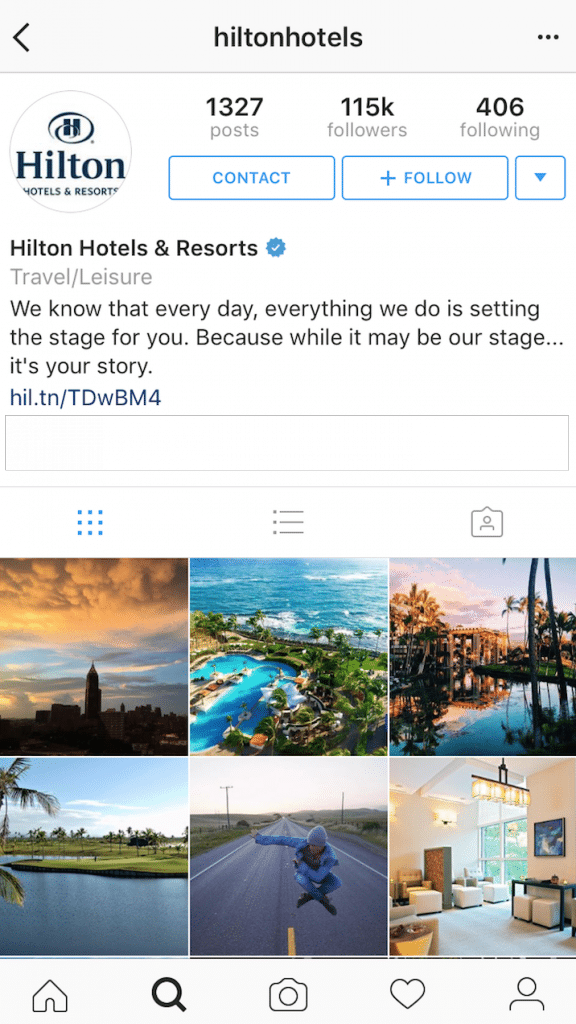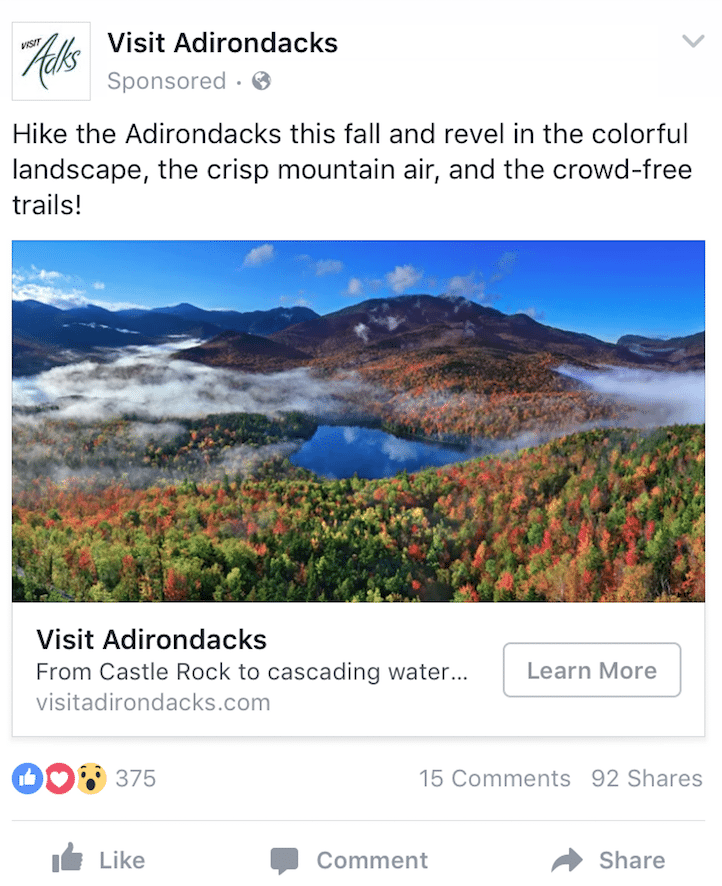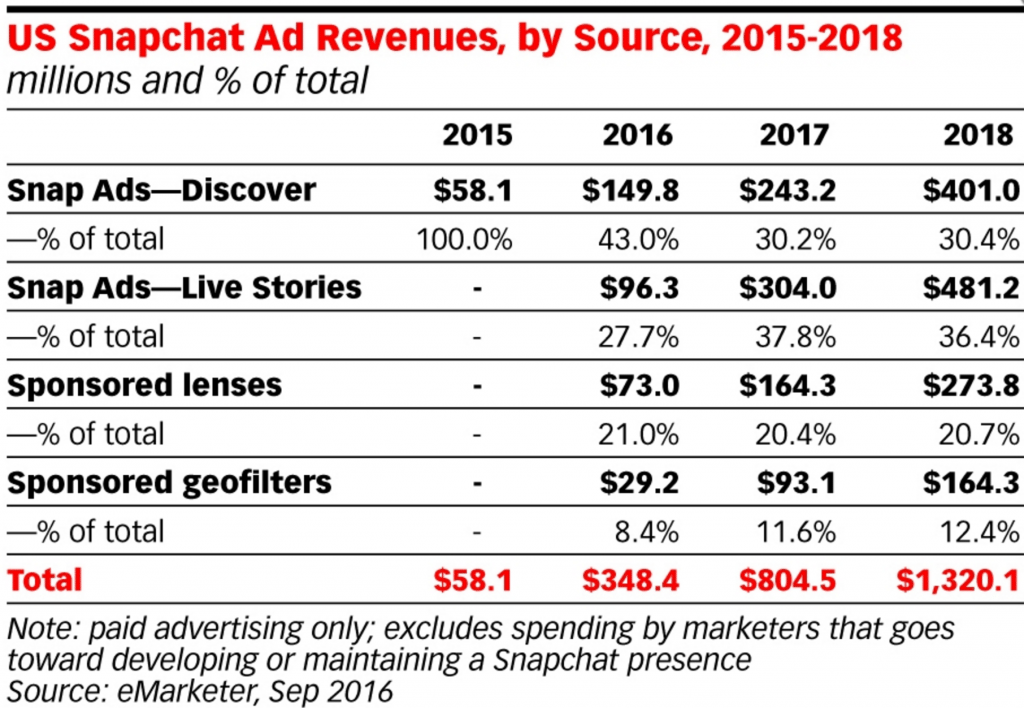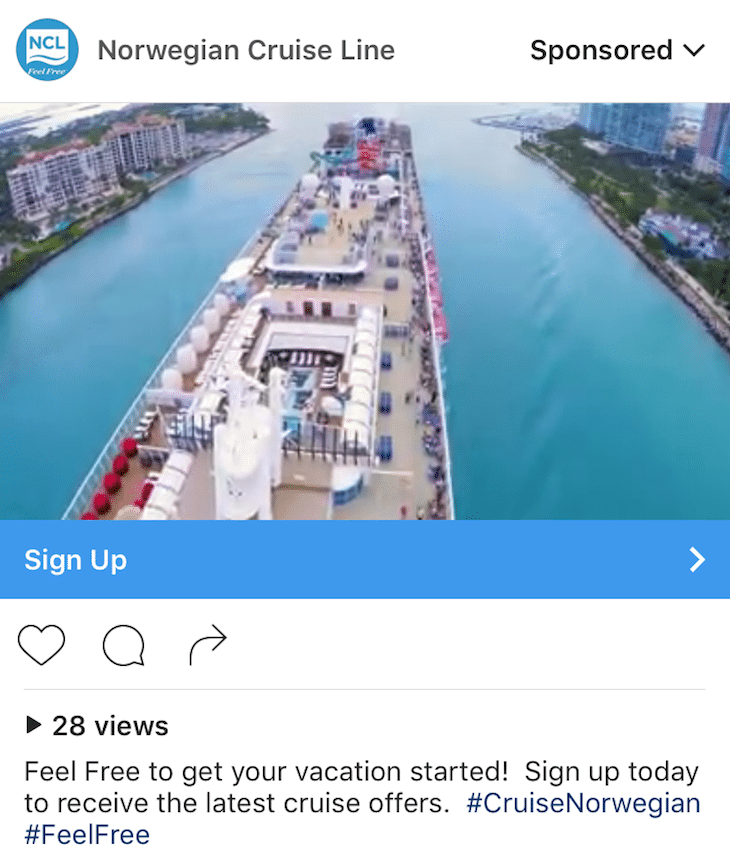Many travel brands are loading their social media channels with user-generated content and influencers to inspire conversations with travelers, but they’re also putting weight behind advertising on social — something becoming more common in general across those platforms.
Some 46 percent of travel brands are advertising on social media this year, a 12.1 percent increase over 2015, according to market research company eMarketer, and many that do say social media ads are effective at reaching the right travelers. Facebook updated its ad preferences last month to give travelers more control over what kinds of ads they see and five-year-old Snapchat is expected to net more than $366 million in ad revenue this year and nearly $1 billion next year. It’s evident that travel brands value both social advertising and user-generated and organic content and that travelers are encountering more ads on social channels once reserved for friends and family.
TV, print, and other offline ad channels, however, are still the largest advertising mediums for travel brands. Visit Adirondacks, the destination marketing organization for the Adirondacks region in Upstate New York, has been running Facebook ads for several years and told Skift that Facebook, the platform it uses most for social advertising, accounts for 10 percent of its ad budget but expects that number to increase. “We’re using Facebook ads versus Google right-hand rail more because we feel Facebook ads perform better,” said Dave Conlan, director of client services at Adworkshop, a digital marketing agency behind Visit Adirondacks’ social ads. “We’re also advertising on Instagram but we’re not seeing the same return on Instagram as we do on Facebook.”

Hilton’s profile on Instagram
Though Instagram is becoming more useful to brands to help them monetize the platform. It recently added a contact button for businesses (see example of Hilton Hotels & Resorts at right) that users can tap to either call, email, or get directions.
Conlan said Twitter isn’t a player for the destination’s advertising, which represents a larger trend with most travel brands. “Twitter is not used for travel discovery, planning or inspiration. We might do a paid promotion around a Twitter chat, for example, but overall we don’t really need to do that, it’s just nice to do that. Twitter is huge for hospitality brands but from a DMO perspective Twitter is in a lot of aspects out of our purview.”
Travel Brands Monetizing Social Media
Visit Adirondack’s goal with Facebook ads is to reach out-of-state travelers since Facebook lets brands target and retarget consumers based on their locations and interests. The brand’s Facebook ads are meant to grow brand awareness first and drive conversions and visits second, said Conlan. “Any time that we’re putting dollars behind paid ad content we’re seeing an increase in engagement,” he said. The destination recently ran video ads on Facebook that garnered more than one million views from out-of-state travelers potentially interested in visiting the Adirondacks region.
A currently-running ad for Adirondacks hiking trails (see screenshot below) has more than 1,000 likes, dozens of comments and 250-plus shares and compliments the destination’s Facebook and other social marketing that spotlights experiences unique to the region.
Social media marketing is all about experiences — or so brands claim — and advertising should mirror that strategy, said Carlos Gil, a Snapchat strategist and global head of social media at BMC Software. “People want to see in ads that it’s all about the experience. Even if it’s an ad. If it’s just your standard ‘Hey we’re running a sale and come buy from us,’ that isn’t going to work. It has to be fun. Coke and Pepsi do an excellent job with keeping their Snapchat ads very upbeat and fun.”

Visit Adirondacks on Facebook.
Gil said monetization comes slowly. “You have to build an audience and engage consistently and then after that you start to monetize. I tell brands that want to join Snapchat that they need to create a 12 to 18 month strategy that puts them on the path towards seeing pay offs.”
Gil is bullish about Snapchat’s marketing reach and advertising potential (see chart below). Its 150 million active, mainly millennial users and counting and eMarketer’s projection that 44 percent of U.S. users will be ages 40 or older by 2020 are attractive to brands even if Snapchat ads are currently only 2.3 percent of all social ad budgets for all industries.
Snapchat ads are weaved between stories and users can immediately choose to skip them if they’re not interested in watching. Unlike Facebook which doesn’t seem to limit the number of ads it shows users, Snapchat only shows three ads per day, one in the morning, one in the afternoon and one in the evening. “Above everything else, it’s a storytelling app,” said Gil. “The challenge is how can a brand tell their story in ten seconds or less? That’s how long a Snapchat ad can be.”

Source: eMarketer
State of Advertising on Facebook
Facebook remains the big fish for social advertising and its ad products are the most mature of any major platform. Its advertising revenue was $6.2 billion for the second quarter alone, up 63 percent year-over-year, and some 60 million brands use Facebook ad products. Mobile ad revenue was $5.2 billion of its total ad revenue, up 81 percent.
Facebook plans to place more ads in users’ newsfeeds during the next year but won’t push as many on Instagram as on Facebook, said David Wehner, Facebook’s chief financial officer, during the company’s second quarter earnings call on July 27. “The optimal ad load is really a mix of art and science…We also want to be thoughtful about making sure that each person’s overall feed experience has the right balance of organic and ad content…And that’s really why we’re talking about our expectation that as you get into mid-2017, ad load will not be a big factor in driving overall inventory growth.”
Sheryl Sandberg, Facebook’s chief operating officer, specifically highlighted dynamic ads for travel brands during the call. Facebook launched dynamic ads for travel brands and expanding dynamic ads to Instagram during the second quarter. Dynamic ads, seen by 300 million people each month, according to Sandberg, allow advertisers to upload their product catalogs and target users with specific products in real-time. Sandberg said this allows hotels to advertise certain destinations and dates for hotel rooms, for example.
Facebook advertisers get the benefit of the Facebook Audience Network which pushes ads across a network of other apps and sites. Facebook also serves ads on the Facebook app from a user liking a hotel’s post on Instagram, for example, and vice versa. Wehner said the U.S. and Canada and Asia-Pacific were Facebook’s fastest-growing regions for advertising with growth rates of 69 and 67 percent, respectively, for the second quarter. Ad revenue growth was broad-based across verticals, marketer segments and regions, he said.
What is the Ideal Travel Ad?
Conlan said social media ads can’t be hard sells and should have the same tone and excitement as non-ad content. “You wouldn’t see a contrived, set-up scene in an ad for the Adirondacks because travelers can read right through that. Hopefully the ad looks as natural as it could be and it shows that the brand is approachable,” said Conlan.

Norwegian Cruise Line sponsored post on Instagram.
Some brands don’t take that road. Norwegian Cruise Line is currently running an Instagram video ad featuring its newest ship, the Norwegian Escape, with music from Pitball. While the music keeps the tempo upbeat and Pitball’s lyrics, “I’m free to do what I want and have a good time,” align well with the brand it doesn’t show you what you’re free to do or how you can have a good time onboard. The ad only shows zoomed-out shots of the ship from various angles.
Gil said some brands are advertising on social without actually advertising. “W Hotels and MGM Resorts are both doing really well on Snapchat with its sponsored geofilters at all of their properties (see screenshot of the the Park Las Vegas’ Snapchat filter below). They’re on Snapchat without having to necessarily push out content on Snapchat because travelers are using the filter in their Snapchat stories and W is making Snapchat all about the customer.”
An ad is still ad no matter how it’s dressed up. Social media advertising is a two-way conversation where travelers engage with brands and instantly offer feedback unlike other ad platforms. Social is fundamentally changing how brands view advertising but most haven’t grasped that two-way conversation reality. Many social ads talk at the consumer rather than engage them and that’s one of the greatest ad hurdles brands are facing.

A screenshot of the Park Las Vegas’ Snapchat filter.
This article first appeared in www.skift.com

